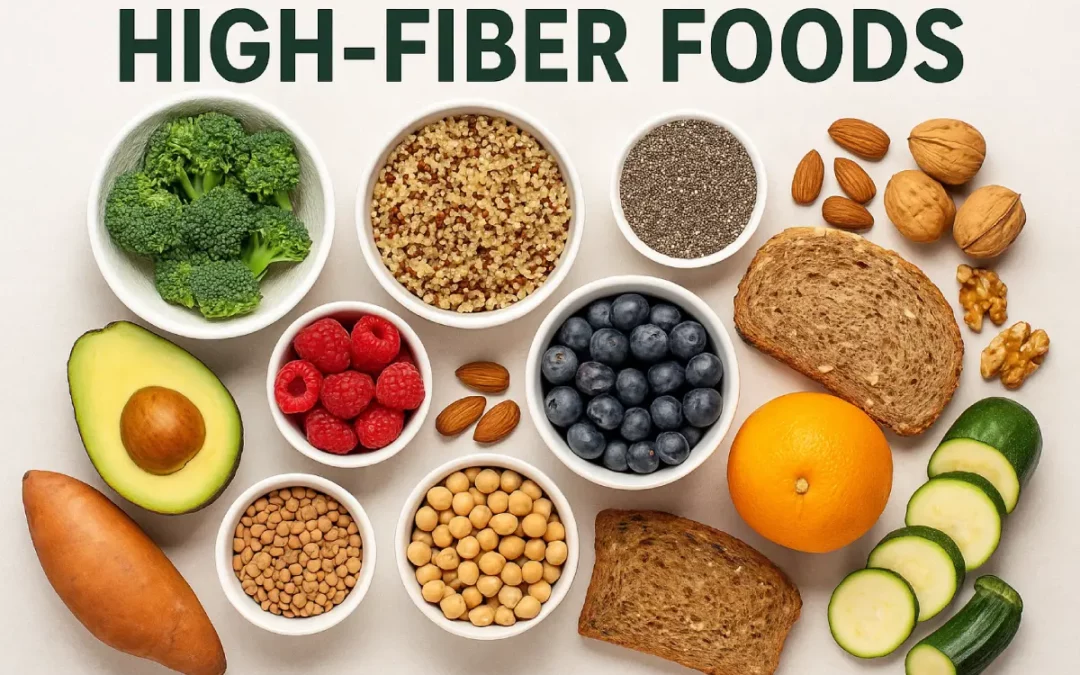Fiber is one of the most essential yet underrated components of a healthy diet. From improving digestion to supporting heart health and stabilizing blood sugar, eating enough fiber is a foundational habit that benefits nearly every system in the body. Eat enough fiber for gut health and you’re not just improving your microbiome balance — you’re also supporting your heart and metabolic function.
In this comprehensive guide, we’ll explore:
-
What dietary fiber is
-
How much fiber you need
-
Why it matters for gut, heart, and metabolic health
-
The best high-fiber foods
-
Simple strategies to increase fiber intake
-
Expert-backed answers to common fiber-related questions
Let’s dig in.
What Is Dietary Fiber?
Fiber is the indigestible part of plant foods. Unlike fats, proteins, and carbohydrates, it passes through your digestive system largely intact.
Two Types of Fiber:
-
Soluble fiber: Dissolves in water to form a gel-like substance. It slows digestion, reduces cholesterol, and stabilizes blood sugar.
-
Insoluble fiber: Adds bulk to the stool and helps move food through your digestive tract efficiently, promoting regular bowel movements.
Most fiber-rich foods contain both types in varying amounts.
Why Eating Enough Fiber Is So Important
A fiber-rich diet supports digestive, cardiovascular, metabolic, and immune health. Let’s break down the benefits.
✅ 1. Supports Healthy Digestion
-
Promotes regular bowel movements
-
Prevents constipation and bloating
-
Feeds beneficial gut bacteria (prebiotic effect)
-
Produces short-chain fatty acids (SCFAs) like butyrate that nourish the colon
A healthy microbiome starts with feeding it the right fuel—fiber is that fuel.
✅ 2. Reduces Risk of Chronic Disease
High-fiber diets are linked with a lower risk of:
-
Heart disease
-
Type 2 diabetes
-
Stroke
-
Certain types of cancer (especially colorectal)
Soluble fiber, in particular, helps lower LDL (bad) cholesterol and regulate blood sugar levels by slowing glucose absorption.
✅ 3. Helps With Weight Management
Fiber increases satiety (the feeling of fullness), helping prevent overeating and unnecessary snacking. It:
-
Slows gastric emptying
-
Balances hunger hormones
-
Reduces overall calorie intake
✅ 4. Supports Blood Sugar Control
Soluble fiber is key for glycemic control, especially in people with insulin resistance or prediabetes. It helps:
-
Slow carbohydrate absorption
-
Reduce post-meal blood sugar spikes
-
Improve insulin sensitivity
How Much Fiber Do You Really Need?
According to the Academy of Nutrition and Dietetics and other health authorities:
| Group | Recommended Daily Intake |
|---|---|
| Adult Women | 25–30 grams |
| Adult Men | 30–38 grams |
| Children (1–18) | 14–31 grams (age-dependent) |
The average person consumes only 10–15 grams per day—far below the ideal.
Best High-Fiber Foods to Include Daily
You don’t need supplements to hit your fiber goals. Focus on whole plant foods with a variety of colors and textures.
Fruits
-
Raspberries (8g/cup)
-
Apples with skin (4.4g/medium)
-
Pears (5.5g/medium)
-
Bananas (3g/medium)
Vegetables
-
Broccoli (5g/cup)
-
Carrots (3.5g/cup)
-
Brussels sprouts (4g/cup)
-
Sweet potatoes with skin (4g/medium)
Whole Grains
-
Oats (4g/cup cooked)
-
Brown rice (3.5g/cup)
-
Quinoa (5g/cup)
-
Whole wheat bread (2g/slice)
Nuts, Seeds & Legumes
-
Lentils (15g/cup cooked)
-
Chickpeas (12g/cup)
-
Chia seeds (10g/2 tbsp)
-
Almonds (3.5g/oz)
Tip: Include a mix of both soluble and insoluble fiber sources throughout the day for best results.
Simple Ways to Add More Fiber to Your Diet
Even small changes can make a big difference:
-
Add chia or flaxseeds to smoothies or oatmeal
-
Replace white rice with quinoa or farro
-
Snack on fruit and nuts instead of chips or cookies
-
Eat the skins of fruits and vegetables
-
Start meals with a fiber-rich salad
-
Choose whole grain versions of bread, pasta, and cereals
-
Include beans or lentils in soups, stews, and salads
Common Questions About Fiber Intake
Can Too Much Fiber Be Harmful?
Yes—too much fiber too quickly can cause bloating, gas, and discomfort. To avoid this:
-
Increase intake gradually
-
Drink plenty of water (2–3 liters/day)
-
Chew thoroughly
What’s the Best Time to Eat Fiber?
Fiber is beneficial at all meals. However, starting your day with a high-fiber breakfast (like oats, fruit, or whole grain toast) can:
-
Improve satiety all day
-
Reduce cravings and blood sugar swings
Is Fiber Good for IBS?
It depends on the type. People with Irritable Bowel Syndrome (IBS) often do better with soluble fiber (e.g., oats, carrots, chia seeds) and may need to avoid insoluble or fermentable fibers (FODMAPs) temporarily.
Always consult a qualified nutritionist or gastroenterologist for personalized guidance.
Expert Insight: What Doctors and Dietitians Say
“Fiber is foundational for a healthy gut and long-term disease prevention. The best way to increase it is through real, whole foods.”
— Dr. Will Bulsiewicz, MD, gastroenterologist and author of Fiber Fueled
“Instead of counting calories, start counting fiber grams. The higher your fiber intake from real food, the healthier your microbiome.”
— Monique Richard, RDN, Academy of Nutrition and Dietetics
Final Thoughts: Small Steps Lead to Big Gains
Eating enough fiber for gut health is one of the simplest, most cost-effective ways to improve your health. It boosts digestion, strengthens the immune system, helps control blood sugar, and reduces disease risk.
Start Today:
-
Swap refined grains for whole grains
-
Add a fruit or veggie to every meal
-
Drink more water to help fiber do its job
With consistent effort, your gut—and entire body—will thank you.
Sources & References:
-
Slavin, J. (2013). Dietary fiber and body weight. Nutrition, 29(4), 473–477.
-
Reynolds, A. et al. (2019). Carbohydrate quality and human health: a series of systematic reviews and meta-analyses. The Lancet, 393(10170), 434–445.
-
National Institutes of Health – Office of Dietary Supplements



